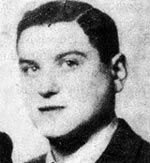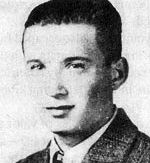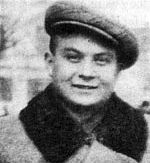 |
 |
 |
|
Such activities were punishable by death; many paid the price of being arrested and deported, among them shochet Yehoshua Lerner and butcher Berek Pudlowski, who was caught when bringing a cow (live) up flights of stairs for slaughter.
Bribery was a big factor in disobeying the draconian rules of the oppressor. For example, in 1940, a large group of young men was deported to various labor camps in the Lublin area. A man name Gomberg was dispatched by the Council and was successful in releasing the boys in exchange for a large sum of money paid to the SS monster Dolf.
A hard task was satisfying the extortion demands by the Germans. On December 2nd, 1939, the Council was ordered to deliver a thousand men for forced labor each day and to pay their wages. In addition, the constant demands for the delivery of pianos, furs, furniture, etc., plus three cash contributions of a total of three hundred and ninety thousand zlotys greatly afflicted the people. In January, 1940, the Stadtkommissar demanded all leather and textiles from Jewish stores. The Council then submitted several memoranda to the occupants boldly describing the desperate situation and requesting that the community be spared in the future.
The people also responded with defiance. They sold or gave away the furs and other forbidden articles to the Poles or simply destroyed them.
Widespread welfare and medical aid was initiated in the ghetto by the Council – a kitchen for the needy, milk distribution for babies and children, shelters, clinics and many other facilities. Despite hard living conditions, some cultural activities were organized.
People tried somehow to brighten up their gloomy existence. There were a few illegal libraries, providing a vigorous book exchange; amateur theater groups were active and performed, form time to time, before selected audiences. Musicians performed, mostly chamber music.
The ghetto was established in the oldest and drabbest part of the city. All the parks and gardens were located beyond our reach. In 1940, a special squad of “new made” gardeners was organized. They planted flowers and greenery, beautifying the gloomy ghetto backyards and squares.
The religious people, in defiance of the rules, observed the Sabbath and Holidays as much as possible. A group of orthodox activists was responsible for saving holy books and scriptures. They succeeded in saving over three hundred religious objects from sacrilege.
A separate chapter of courage and dedication was written by the teachers of the ghetto. Soon after the smoke in 1939 had settled, they started their immense and very useful activities. Some joined forces and maintained a regular educational system conducted in strict secrecy. Every false move invited serious consequences. The youngsters were told to enter the flats one by one and carry their notebooks under their clothes. Sometimes the class had to stop in the middle of a session and disperse rapidly when the Germans were riding the block. This underground education was one of the most powerful expressions of passive resistance.
Various organizations continued their activities in the ghetto. Understandably, they were limited. The Bund movement held regular meetings and maintained close contact with their Central Committee in Warsaw, receiving underground literature and outlines for eventual active resistance. In July, 1941, a Polish underground courier, Maria Szczesna, was arrested by the Gestapo while carrying illegal publications and the names of most of the Council as underground activists. The Germans learned who was involved in the resistance and rescue endeavors. Shortly thereafter, a few of the Council members were arrested, among them chairman Zalman Tenenberg, treasurer Zalman (Stach) Staszewski, Maierowicz, Fraint and others. One of them, Jacob Berliner, surrendered to the Germans of his own will in solidarity with the arrested colleagues. They were sent to Auschwitz, and, shortly afterward, a telegram arrived stating that they all had died.
Despite the loss of their most important leaders, a group of Bund's younger activists kept in contact with Warsaw. Even in 1943, they were receiving large sums of money and underground pamphlets. All this was distributed among their fellow members.
|
|
|
|||||
| Josek Goldberg | Welwek Goldberg | Mendel Goldberg |
Many others were arrested and killed for possession of illegal material, among them Itka Lipnicka, Niusia Modkowicz and Lusia Weishoff. Lolek Kon lost his life for possessing a stinging satire about Hitler and Stalin.
The Hashomer Hatzair movement also continued its work in the ghetto. In February, 1940, an emissary from the Warsaw Hanhagah Rashit came to Piotrkow. His name was Mordechai Anielewicz; he later became the commander of the Warsaw Ghetto Uprising. His mission was to spread the gospel of resistance. After his visit, the contact with Warsaw was kept and Jakov Aronowicz, the head of the Ken in Piotrkow, attended a conspiratorial meeting in Warsaw dealing with future resistance policy and behavior. A special code was used in communicating with Warsaw. After the war, letters in such code, written by Aronowicz and Zarnowiecki, were found in the underground ghetto archives.
Movements such as Betar, Hanoar and others also conducted meetings and discussions. The subjects were mainly resistance and freedom.
There were several attempts of active resistance in the ghetto of Piotrkow. Let us mention with esteem the heroic outbreak of brother Goldberg and Liberman, members of Betar. At their workplace, they made contact with a Polish foreman. For an exorbitant fee, the man was ready to deliver guns and ammunition and also firemen's uniforms. He claimed to be a member of an Armia Krajowa unit and promised safe passage to their hideout in a nearby forest.
On a set day, the foreman delivered the arms and uniforms. He did not tell the boys that the bullets were blanks. At midnight, the five youngsters crossed the ghetto wall. The man led them to the Sulejow forest and left them there. They were soon surrounded by Germans. A gun fight ensued. But how do you fight an enemy with blank bullets? Soon they were captured, some of the boys wounded. The Gestapo brought them in for torturous interrogation. Shmuel Katz, the hat maker who made the firemen's caps, and Szymek Nyss, who helped them to cross the ghetto wall, were implicated. All those seven courageous men were brought to the Jewish cemetery and shot.
Some young men were successful in joining the Polish underground. One of them, Julek (Kazik) Szmulewicz (Small), escaped from Bugaj and was accepted by an Armia Ludowa unit, a left-oriented fighting force which had a policy of helping Jews. With them, he fought the enemy and, after the war he became an officer in the Polish Army. Heniek Goldhersh (pseudonym Wywra) and Heniek Ryterband fled from Bugaj and joined a different AL group. Just days before the Russian front reached Piotrkow in 1945, they were in combat with the Germans in the Milejow forest. Heniek Goldhersh lost his life; Heniek Ryterband survived.
At the same time, another young man also escaped from Bugaj. His name was Motek Szteinberg. He had difficulties in making contact with the underground and returned to the camp. Miraculously, he wasn't killed by Dietrich or Fisher and survived the Holocaust. He lost his young life in 1948 defending kibbutz Degania on the banks of the Kinereth.
|
|
|||
| Julian (Kazik) Szmulewicz (Pseudonym "Jelen") |
Bernard (Bendit) Flatto Fought in the French Resistance |
|
|
|||
| Motek Sztajnberg. Escaped from The Bugaj to join the partisans. Returned, however, unable to Make contact. Died heroically During the Israeli War of Independence |
Hersz (Henick) Goldhersz |
It's impossible to mention all such stories of valor in one short essay. History teaches that there are two ways to resist – actively and passively. Active resistance is possible when the will rises in enough people to make the supreme sacrifice for honor and freedom. However, support from the outside is the ultimate condition.
For ages, the Jews in Poland were dispersed among hostile, sometimes reactionary and prejudiced masses. When the Germans came, we were contained in ghettos, where annihilation could proceed swiftly at a moment's notice without even the remote possibility of resistance. We were also cruelly deceived and alone. Still today, we cannot rid ourselves of the awful feeling of isolation that we experienced so deeply at that time. To set a foot out of the ghetto meant to be hunted day and night. And from the outside world, in answer to our cries, came only shattering silence.
The road to survival we instinctively took was the only one possible fit for sanity. Those who blame us today for our lack of active resistance then are only trying to cover up their own guilty consciences, to cover up the dark moments in the history of mankind, when the world stood silent.
| |
| Yakov and Eliezer Liberman |
| |
| At the grave of Hersz (Heniek) Goldhersz. (Pseudonym “Wyrwa”) |
|
JewishGen, Inc. makes no representations regarding the accuracy of
the translation. The reader may wish to refer to the original material
for verification.
JewishGen is not responsible for inaccuracies or omissions in the original work and cannot rewrite or edit the text to correct inaccuracies and/or omissions.
Our mission is to produce a translation of the original work and we cannot verify the accuracy of statements or alter facts cited.
 Piotrkow Trybunalski, Poland
Piotrkow Trybunalski, Poland
 Yizkor Book Project
Yizkor Book Project
 JewishGen Home Page
JewishGen Home Page
Copyright © 1999-2026 by JewishGen, Inc.
Updated 16 Feb 2010 by LA